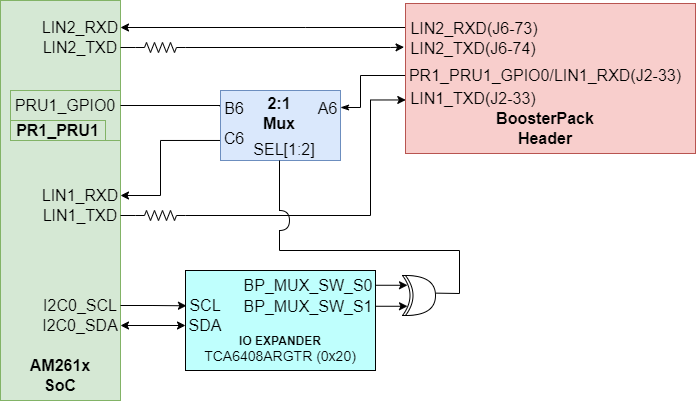SPRUJF1 November 2024 AM2612
ADVANCE INFORMATION
- 1
- Description
- Key Features
- 1LaunchPad Module Overview
-
2Hardware Description
- 3.1 Board Setup
- 3.2 Functional Block Diagram
- 3.3 GPIO Mapping
- 3.4 Reset
- 3.5 Clock
- 3.6 Memory Interfaces
- 3.7 Ethernet Interface
- 3.8 I2C
- 3.9 Industrial Application LEDs
- 3.10 SPI
- 3.11 UART
- 3.12 MCAN
- 3.13 FSI
- 3.14 JTAG
- 3.15 TIVA and Test Automation Pin Mapping
- 3.16 LIN
- 3.17 ADC and DAC
- 3.18 EQEP and SDFM
- 3.19 EPWM
- 3.20 USB
- 3.21 BoosterPack Headers
- 3Known Issues and modifications done on LP-AM261 RevE1
- 4Additional Information
- 5References
- 6Revision History
2.16 LIN
The AM261x LaunchPad supports Local Interconnect Network communication with two LIN instances mapped to the BoosterPack header.
Note: The AM261x does not have an onboard
LIN Transceiver
 Figure 2-23 LIN Instances to BoosterPack Header
Figure 2-23 LIN Instances to BoosterPack HeaderLIN2_TXD, LIN2_RXD and LIN1_RXD signals are directly routed to BoosterPack connectors. LIN1_TXD is going through a 2:1 mux and selection table is given below.
Table 2-11 LIN 2:1 Mux
| BP_MUX_SW_S1 | BP_MUX_SW_S0 | Function of 2:1 Mux | Signals to BP Header |
|---|---|---|---|
| LOW | LOW | Port A ↔ Port C | LIN1_TX |
| LOW | HIGH | Port A ↔ Port B | PR1_PRU1_GPIO0 |
| HIGH | LOW | Port A ↔ Port B | PR1_PRU1_GPIO0 |
| HIGH | HIGH | Port A ↔ Port C | LIN1_TX |